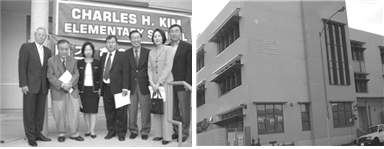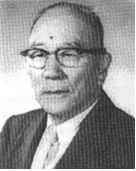Born in Seoul, Han-sa Kim Ho’s birth name was Kim Jeong-jin. When he exiled to China in 1912, he changed his name to Kim Ho to cross the border. He received modern education at Hanseong School (the predecessor of Gyeonggi High School) and attended Jeongdong Church with his mother. He taught new subjects at schools established by missionaries, including Paichai, Ewha, and Yeongheung Schools, as well as Daeseong School, which was founded by Ahn Chang-ho in Pyongyang.
Until he left his homeland, he taught at Daeseong School, which aimed to promote independence ideology and national consciousness. He initiated a movement to lower the Japanese national flag (not to raise it high) and produced the first graduating class in 1912, but the school was closed by the Japanese authorities. After leaving this school, Kim Ho dedicated himself to the Korean independence movement, working as a driver in Shanghai for three years to save money for his journey to the United States, where he exiled on July 25, 1914. Initially, he worked labor jobs to support himself, but as his situation improved, he became increasingly involved in the Korean-American community and supported patriotic activities for his homeland’s independence. In 1919, he organized the Labor Society for Social Advancement to support the diplomatic activities of the provisional government.
After the March 1st Movement in 1919, he became a special envoy for the Korean National Central Association in San Francisco, touring the western United States for two months and raising over ten thousand dollars in independence funds. This fund played a crucial role in the finances of the Provisional Government of the Republic of Korea in April 1919.
In 1920, he moved to Ridley, Central California, and established Kim Brothers Company in partnership with Kim Hyeong-soon. The success of this business allowed him to send substantial funds for independence and provide jobs for Korean immigrants and students who had moved from Hawaii to the mainland. He was also successful in developing nectarines (a fuzzless peach) by grafting plums and peaches. Under the Le Grand and Sun Grand brands, he supplied nectarines across the United States, reportedly producing so much from six farms covering 500 acres that he could not sell all of it.
He employed hundreds of Koreans and established a fruit packing company to supply wholesalers. The fact that 120 trucks were mobilized during peak seasons indicates the enormous scale of his business. In 1937, he was elected president of the North American Korean National Association and led the Korean community again in 1945 and 1949 as the chairman of the central executive committee.
When the Pacific War broke out in 1941, he submitted a plan to the U.S. Army Command for the formation of a Korean Defense Army and established the Korean Defense Corps, the Tiger Army, in Los Angeles. In June 1936, he participated in a revival movement for the organization, improving the system of the North American Korean National Association, and was elected as the first central executive chairman in January 1937, working for the Korean community in North America. He played a significant role in the formation of the Korean American United Committee in 1941, which unified Korean political organizations across the Americas, and became the executive chairman in Los Angeles in 1942.
On August 29, 1942, the day of national humiliation, he arranged for the national flag to be raised at Los Angeles City Hall, moving and exciting Koreans throughout the Americas.
He also actively promoted Korea’s position by publishing the monthly magazine “Voice of Korea.” In 1944, the Korean United Association established a diplomatic office in Washington, D.C., and Kim Ho was appointed as a diplomatic committee member alongside Kim Won-yong. In 1945, the Provisional Government appointed Kim Ho as a representative to the Allied Conference, calling him back to Korea, and in December 1946, he was elected as a legislative committee member for South Korea.
Kim Ho returned to the United States in 1949 and continued to serve as the chairman of the central executive committee of the Korean National Association. In May 1957, he established the Korean Foundation in the Ridley area and served as its head. After his death, he was initially buried in Ridley Park Cemetery but was later reinterred at the National Cemetery in Daejeon in September 2003. The South Korean government awarded him the Order of Merit for National Foundation in 1997.

In 2007, Charles H. Kim Elementary School (김호 초등학교) opened at the intersection of Western and 3rd Street (225 S. Oxford Ave, LA), becoming the first public school in the United States named after a Korean in the 100-year history of Korean immigration to America.

Leave a Reply